I followed several deer trails, through marsh and field, and poked around beneath coniferous trees. One of the first things I found was a spot where a rabbit had been consumed: soggy fur and entrails littered the slushy snow, and crow footprints led to and from the scene. On the muddy bank of a stream, I discovered some fantastic examples of raccoon footprints, and a few yards away, I found the skeleton of a raccoon:
Most of the bones were under the leaf litter. The skeleton belonged to a rather young individual, as the sutures on the skull had not yet fused, and some of the bones (mostly the vertebrae and leg bones) had not completely fused, either. This is the third raccoon skeleton I've found since moving to Ann Arbor, and the second I've found at the Matthaei Botanical Gardens.
The real find of the day, though, came about thirty minutes later. I was slogging through a field, my feet cold and wet, when I saw a turkey vulture take to the sky. It had been eating something, and I knew I had to investigate. As I drew closer, and the vulture circled overhead, I saw one antler, and then another -- it was a dead buck, resting beneath a lone cedar.
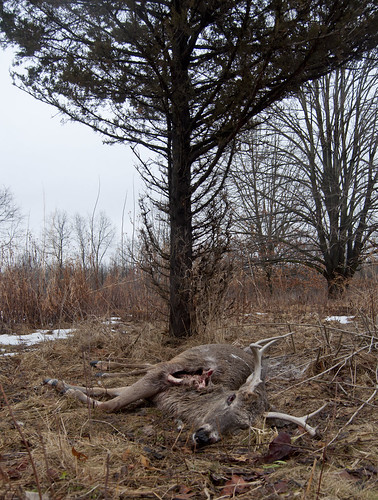
It took me a while to decide how old the body was. At first, I thought the death was rather recent, but the buck's hindquarters had decomposed quite a bit. At the same time, the front half of the deer -- especially the head -- was in remarkably fresh condition. One eye had been pecked out, likely by the vulture, but the other eye was intact. I finally came to the conclusion that the buck's body, at least most of it, had been buried beneath the snow for some time, and was only recently revealed in the latest melt.
The first thing I noted was that the buck had seven tines on his set of antlers, and one of them, the right eye guard, had been damaged at some point, either during the rut or while he was still in velvet. In addition, his antlers were much whiter than I'm used to seeing.
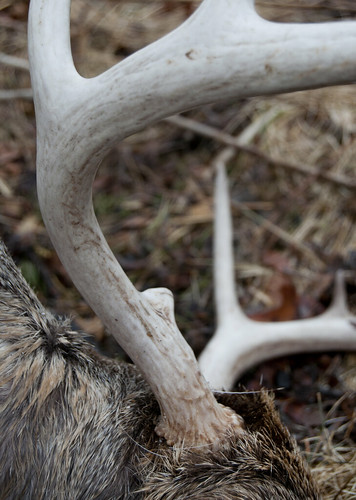
The first thing I noted was that the buck had seven tines on his set of antlers, and one of them, the right eye guard, had been damaged at some point, either during the rut or while he was still in velvet. In addition, his antlers were much whiter than I'm used to seeing.

The second thing I noticed was far more mysterious and worrisome. On the buck's left foot, stuck between his hooves and dewclaws, was a thick, plastic band. It was hard to look at: the skin and bone had grown around it, resulting in a misshapen, malformed foot, and his hooves had grown long and deformed as a result of the injury.
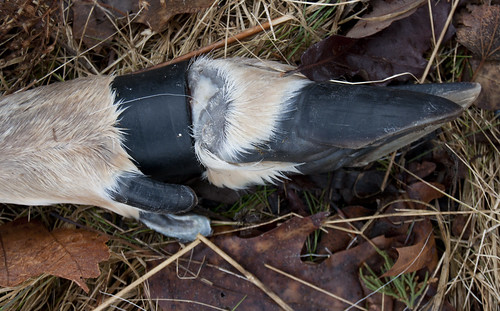

It's obvious that this buck had been in a lot of pain. I have to wonder how much this injury hampered his movement, and if it got infected. Perhaps this led to his death; I can't imagine a limping deer would fare too well in deep snow. I can only assume that early on in this buck's life, he stepped into the tube, and it never came off.
The buck was certainly a challenge to photograph. Though it was in good condition, his face was not very dignified looking, and the rest of his body was in the process of being picked at by vultures. As a result, I focused on his antlers: they were stately, proud, and more or less permanent, unlike his fur and muscle.
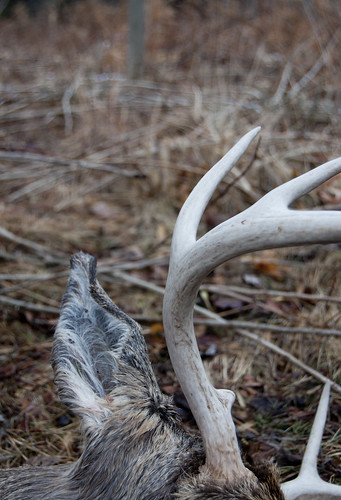
The buck was certainly a challenge to photograph. Though it was in good condition, his face was not very dignified looking, and the rest of his body was in the process of being picked at by vultures. As a result, I focused on his antlers: they were stately, proud, and more or less permanent, unlike his fur and muscle.

After I finished photographing the deer, my mother joined me with a couple of saws and a lopper. It took an amazing amount of sawing -- and now I understand what the scavenging vultures and crows are up against! -- but my mother was finally able to break through the fur, skin, muscle, and bone. Like September Squirrel, I will observe the decomposition of this buck's head in my parents' backyard. It will be interesting to note the differences in both the scavengers and speed of decay in comparison to the rest of the body, which I will check up on periodically, as well.
We also cut the plastic band from the buck's foot; I will keep that, too, as a reminder of what happens when garbage is discarded so carelessly.
We also cut the plastic band from the buck's foot; I will keep that, too, as a reminder of what happens when garbage is discarded so carelessly.

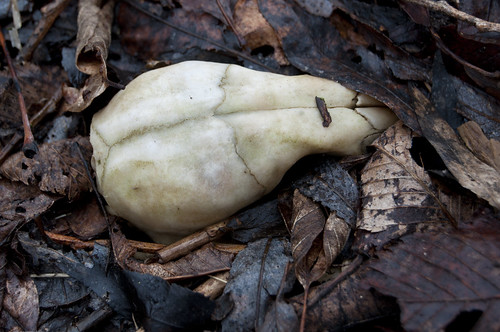



No comments:
Post a Comment